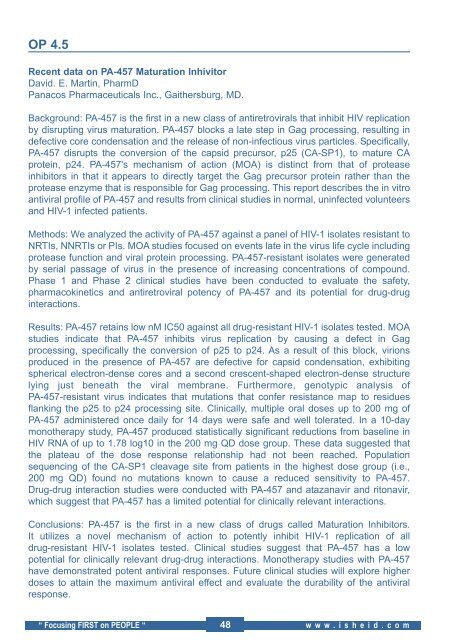final program.qxd - Parallels Plesk Panel
final program.qxd - Parallels Plesk Panel
final program.qxd - Parallels Plesk Panel
You also want an ePaper? Increase the reach of your titles
YUMPU automatically turns print PDFs into web optimized ePapers that Google loves.
OP 4.5<br />
Recent data on PA-457 Maturation Inhivitor<br />
David. E. Martin, PharmD<br />
Panacos Pharmaceuticals Inc., Gaithersburg, MD.<br />
Background: PA-457 is the first in a new class of antiretrovirals that inhibit HIV replication<br />
by disrupting virus maturation. PA-457 blocks a late step in Gag processing, resulting in<br />
defective core condensation and the release of non-infectious virus particles. Specifically,<br />
PA-457 disrupts the conversion of the capsid precursor, p25 (CA-SP1), to mature CA<br />
protein, p24. PA-457's mechanism of action (MOA) is distinct from that of protease<br />
inhibitors in that it appears to directly target the Gag precursor protein rather than the<br />
protease enzyme that is responsible for Gag processing. This report describes the in vitro<br />
antiviral profile of PA-457 and results from clinical studies in normal, uninfected volunteers<br />
and HIV-1 infected patients.<br />
Methods: We analyzed the activity of PA-457 against a panel of HIV-1 isolates resistant to<br />
NRTIs, NNRTIs or PIs. MOA studies focused on events late in the virus life cycle including<br />
protease function and viral protein processing. PA-457-resistant isolates were generated<br />
by serial passage of virus in the presence of increasing concentrations of compound.<br />
Phase 1 and Phase 2 clinical studies have been conducted to evaluate the safety,<br />
pharmacokinetics and antiretroviral potency of PA-457 and its potential for drug-drug<br />
interactions.<br />
Results: PA-457 retains low nM IC50 against all drug-resistant HIV-1 isolates tested. MOA<br />
studies indicate that PA-457 inhibits virus replication by causing a defect in Gag<br />
processing, specifically the conversion of p25 to p24. As a result of this block, virions<br />
produced in the presence of PA-457 are defective for capsid condensation, exhibiting<br />
spherical electron-dense cores and a second crescent-shaped electron-dense structure<br />
lying just beneath the viral membrane. Furthermore, genotypic analysis of<br />
PA-457-resistant virus indicates that mutations that confer resistance map to residues<br />
flanking the p25 to p24 processing site. Clinically, multiple oral doses up to 200 mg of<br />
PA-457 administered once daily for 14 days were safe and well tolerated. In a 10-day<br />
monotherapy study, PA-457 produced statistically significant reductions from baseline in<br />
HIV RNA of up to 1.78 log10 in the 200 mg QD dose group. These data suggested that<br />
the plateau of the dose response relationship had not been reached. Population<br />
sequencing of the CA-SP1 cleavage site from patients in the highest dose group (i.e.,<br />
200 mg QD) found no mutations known to cause a reduced sensitivity to PA-457.<br />
Drug-drug interaction studies were conducted with PA-457 and atazanavir and ritonavir,<br />
which suggest that PA-457 has a limited potential for clinically relevant interactions.<br />
Conclusions: PA-457 is the first in a new class of drugs called Maturation Inhibitors.<br />
It utilizes a novel mechanism of action to potently inhibit HIV-1 replication of all<br />
drug-resistant HIV-1 isolates tested. Clinical studies suggest that PA-457 has a low<br />
potential for clinically relevant drug-drug interactions. Monotherapy studies with PA-457<br />
have demonstrated potent antiviral responses. Future clinical studies will explore higher<br />
doses to attain the maximum antiviral effect and evaluate the durability of the antiviral<br />
response.<br />
“ Focusing FIRST on PEOPLE “ 48 w w w . i s h e i d . c o m
















